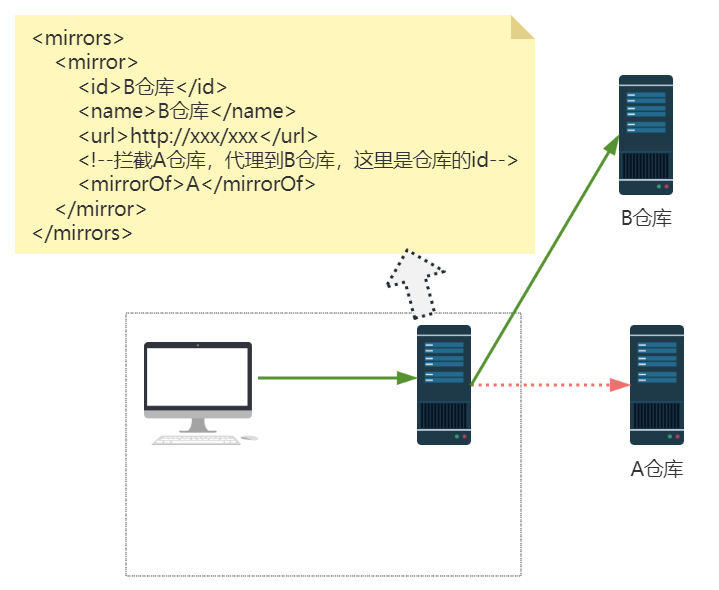Maven进阶系列-仓库和镜像
文章目录
1. 仓库
1.1 仓库类型
本地仓库、远程中央仓库、公司自己搭建的私有仓库

1.2 寻找jar的基本优先级顺序:
本地仓库 > settings.xml的profile的仓库 > pom.xml的profile的仓库 >pom.xml的仓库 > 中央仓库
maven 寻找得顺序大致可以理解为:
1. 在本地仓库中寻找,如果没有则进入下一步。
2. 在全局应用的私服仓库中寻找,如果没有则进入下一步。
3. 在项目自身的私服仓库中寻找,如果没有则进入下一步。
4. 在中央仓库中寻找,如果没有则终止寻找。
补充:
1. 如果在找寻的过程中,如果发现该仓库有镜像设置,则用镜像的地址代替。
2. 如果仓库的 id 设置成 “central”,则该配置会覆盖 maven 默认的中央仓库配置。
设置仓库的方式有两种,一种是在项目最顶级POM.xml中设置,另一种是在settings.xml中设置。
1.3 仓库优先次序验证示例
在pom.xml中设置
<repositories>
<repository>
<id>pom-repository-first</id>
<name>pom-repository-first</name>
<url>http://192.168.100.100:8181/nexus/content/groups/public</url>
</repository>
<repository>
<id>pom-repository-second</id>
<name>pom-repository-second</name>
<url>http://192.168.100.100:8182/nexus/content/repositories/thirdparty/</url>
</repository>
</repositories>
<pluginRepositories>
<pluginRepository>
<id>nexus</id>
<name>Team Nexus Repository</name>
<url>http://192.168.100.100:8181/nexus/content/groups/public</url>
</pluginRepository>
</pluginRepositories>
<properties>
<maven.compiler.source>8</maven.compiler.source>
<maven.compiler.target>8</maven.compiler.target>
</properties>
<profiles>
<profile>
<id>pom-profile-first</id>
<repositories>
<repository>
<id>pom-repository-first</id>
<name>pom-repository-first</name>
<url>http://192.168.100.100:8084/nexus/content/groups/public</url>
<releases>
<enabled>true</enabled>
</releases>
<snapshots>
<enabled>true</enabled>
</snapshots>
</repository>
</repositories>
<!--配置默认的,配置文件,右侧的maven中,profiles默认选中dev-->
<activation>
<activeByDefault>true</activeByDefault>
</activation>
</profile>
</profiles>
settings.xml中设定:
<?xml version="1.0" encoding="UTF-8"?>
<settings xmlns="http://maven.apache.org/SETTINGS/1.0.0"
xmlns:xsi="http://www.w3.org/2001/XMLSchema-instance"
xsi:schemaLocation="http://maven.apache.org/SETTINGS/1.0.0 http://maven.apache.org/xsd/settings-1.0.0.xsd">
<localRepository>D:\Program Files\apache-maven-3.6.1\repository</localRepository>
<mirrors>
<!-- 设置多个mirrors镜像,镜像只会执行第一个位置mirror。-->
<!-- 配置的多个mirror可以都放着不影响,选取一个镜像下载比较快的放在第一个就行。比如你设置使用自己公司的私有仓库-->
<!--只有当前一个mirror无法连接的时候,才会去找后一个,类似于备份和容灾。所以当第一个mirror中不存在a.jar的时候,并不会去第二个mirror中查找,甚至于,maven根本不会去其他的mirror地址查询-->
<mirror>
<!--当有id为B,A,C的顺序的mirror在mirrors节点中,maven会根据字母排序来指定第一个,所以不管怎么排列,一定会找到A这个mirror来进行查找,当A无法连接,出现意外的情况下,才会去B查询-->
<id>aliyun</id>
<name>阿里云仓库地址</name>
<url>http://maven.aliyun.com/nexus/content/groups/public</url>
<!--覆盖了Maven自带的central-->
<mirrorOf>central</mirrorOf>
</mirror>
</mirrors>
<profiles>
<!-- 全局JDK1.8配置 -->
<profile>
<id>jdk1.8</id>
<activation>
<activeByDefault>true</activeByDefault>
<jdk>1.8</jdk>
</activation>
<properties>
<project.build.sourceEncoding>UTF-8</project.build.sourceEncoding>
<maven.compiler.source>1.8</maven.compiler.source>
<maven.compiler.target>1.8</maven.compiler.target>
<maven.compiler.compilerVersion>1.8</maven.compiler.compilerVersion>
</properties>
</profile>
<!-- 阿里云配置: 提高国内的jar包下载速度 -->
<profile>
<id>settings-profile-aliyun</id>
<repositories>
<repository>
<id>settings-repository-aliyun</id>
<url>http://maven.aliyun.com/nexus/content/groups/public/</url>
<releases>
<enabled>true</enabled>
</releases>
<snapshots>
<enabled>true</enabled>
</snapshots>
</repository>
</repositories>
</profile>
<profile>
<id>settings-profile-first</id>
<repositories>
<repository>
<id>settings-repository-first</id>
<name>settings-repository-first</name>
<url>http://192.168.100.100:8183/nexus/content/groups/public</url>
<releases>
<enabled>true</enabled>
</releases>
<snapshots>
<enabled>true</enabled>
</snapshots>
</repository>
</repositories>
</profile>
<profile>
<id>settings-profile-second</id>
<repositories>
<repository>
<id>settings-repository-second</id>
<name>settings-repository-second</name>
<url>http://192.168.100.100:8084/nexus/content/groups/public</url>
<releases>
<enabled>true</enabled>
</releases>
<snapshots>
<enabled>true</enabled>
</snapshots>
</repository>
</repositories>
</profile>
</profiles>
<!--激活仓库配置,拉取依赖会在这些仓库中逐个去找-->
<activeProfiles>
<activeProfile>jdk1.8</activeProfile>
<activeProfile>settings-profile-aliyun</activeProfile>
<activeProfile>settings-profile-first</activeProfile>
<activeProfile>settings-profile-second</activeProfile>
</activeProfiles>
</settings>

2. settings.xml文件
settings 主要由mirrors、servers 和profiles 三部分组成。
2.1 mirrors
mirror相当于一个拦截器,它会拦截 maven 对 remote repository 的相关请求,把请求里的 remote repository 地址,重定向到 mirror 里配置的地址。
2.1.1 没有配置mirror

2.1.2 配置了mirror

上述图中B仓库被称为A仓库的镜像。
2.1.3
<mirrorOf> 标签用于配置镜像仓库的匹配规则,可以指定某个仓库镜像另一个仓库。这样可以加快构建过程中的依赖下载速度,特别是在国内访问外国仓库的情况下。
具体来说,<mirrorOf> 标签用于指定那些仓库将会被当前配置的镜像仓库所代理。比如,如果你在 settings.xml 中配置了一个阿里云的镜像仓库,你可以通过 <mirrorOf> 标签指定这个镜像仓库将代理中央仓库(Central Repository)的某些或全部内容。
例如,以下是一个 Maven settings.xml 配置文件中镜像仓库的示例:
<mirror>
<id>nexus</id>
<url>http://nexus/content/groups/public</url>
<mirrorOf>central</mirrorOf>
</mirror>
在这个示例中,通过 <mirrorOf> 标签配置,表示 naxus 镜像仓库将代理中央仓库(Central Repository),这意味着所有指向中央仓库的请求都会被重定向到 nexus 镜像仓库。
Maven 还支持更高级的镜像配置:
<mirrorOf>*</mirrorOf>:匹配所有远程仓库<mirrorOf>repo1,repo2</mirrorOf>:匹配仓库 repo1 和 repo2,使用逗号分隔多个远程仓库。<mirrorOf>*,!repo1</miiroOf>: 匹配所有远程仓库,repo1 除外,使用感叹号将仓库从匹配中排除。
2.2 servers
在Maven的配置文件(settings.xml)中,标签用于配置 Maven 与远程仓库的认证信息,以便于 Maven 在构建或发布时进行认证。
例如,我们要发布 Maven 项目到 Nexus 私服,可以在 标签中配置私服的地址和认证凭证(用户名、密码等)。这样,当 Maven 在构建或发布时访问私服仓库时,会自动使用这里配置的凭证进行认证。以下是一个 标签的示例配置:
<servers>
<server>
<id>nexus-releases</id>
<username>myusername</username>
<password>mypassword</password>
</server>
</servers>
其中, 标签指定了私服的 ID,这个 ID 通常是 Nexus 中仓库的名称,例如 “nexus-releases”。 和 分别是私服的访问用户名和密码,用于 Maven 认证访问私服。
这样配置后,在 Maven 执行构建或发布时,就会自动使用这里配置的凭证去访问私服,确保 Maven 在发布时具有足够的权力和权限进行发布操作。
2.3 profiles
在 Maven 的配置文件(settings.xml 或 pom.xml)中, 标签用于配置不同环境下的不同构建选项。例如,有些项目会在开发环境下使用 H2 数据库,而在生产环境下使用 MySQL 数据库,这时就可以使用 标签定义两个不同环境。
每个 标签可以包含独立的一组配置,例如 、、、 等,这些配置将仅在该 激活时生效。可以使用 标签来定义激活该 的条件,例如指定操作系统、Maven 版本、当前构建环境等等。
以下是一个 标签的示例配置:
<profiles>
<profile>
<id>dev</id>
<activation>
<activeByDefault>true</activeByDefault>
</activation>
<properties>
<database.driver>org.h2.Driver</database.driver>
<database.url>jdbc:h2:mem:testdb</database.url>
</properties>
</profile>
<profile>
<id>prod</id>
<properties>
<database.driver>com.mysql.jdbc.Driver</database.driver>
<database.url>jdbc:mysql://localhost/mydb</database.url>
</properties>
</profile>
</profiles>
在上述示例中,定义了两个 ,一个 ID 为“dev”,另一个为“prod”。 中设置了 “dev” 是默认激活的配置。在 中配置了不同环境下的数据库驱动和数据库连接 URL。在 Maven 的命令执行中,可以选择使用不同的 Profile 从而达到构建不同的环境的目的。例如:
# 构建 dev 环境
mvn -Pdev clean package
# 构建 prod 环境
mvn -Pprod clean package
通过 标签的使用,可以方便地管理多环境下的不同构建配置,提高了项目的灵活性和可维护性,同时也可以更好地符合软件开发的标准流程。























 3605
3605











 被折叠的 条评论
为什么被折叠?
被折叠的 条评论
为什么被折叠?








